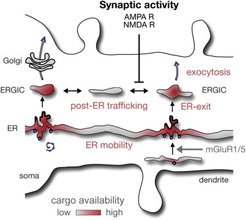Local processing of dendritically synthesized ion channels
Nowadays, many researchers are convinced that in order to adapt to changes neurons must have the possibilities to synthesize proteins locally. Together with colleagues from France and the USA, researchers from the Max Planck Institute (MPI) for Brain Research offered more insight in the local delivery of membrane proteins to synapses. They found that secretory trafficking slows down when synapse are activated, thus likely allowing membrane proteins made in dendrites to follow a more direct route between their site of production and the synapses where they are needed. They published their results in the June 12 edition of Cell Reports.

Trafficking of membrane proteins
Although cytoplasmic proteins can be synthesized locally provided that messenger RNAs, ribosomes and cofactors are at hand, the synthesis of synaptic receptors and other membrane proteins is more problematic. Indeed, these proteins are synthesized and transported by the secretory machinery, a specialized array of intracellular membrane bound compartments and vesicular shuttles, which, in neurons, can potentially transport nascent proteins them far away from their site of production. How these proteins can be delivered locally is unknown.
Using live-imaging and fluorescent reporters, the researchers could follow specific cargo proteins in secretory vesicular shuttles and study how synaptic activation was affecting their behavior. They found that synaptic activity restricts cargo movements by triggering its release from the molecular motors that otherwise pulls and carry it along dendrites. Thus synaptic activity restricts the long-range transport of nascent membrane proteins, enabling a more local and targeted delivery. This might sounds as a contradiction, but can be explained in a very comprehensive way. Cyril Hanus (the first author of the study): "Imagine that you need to turn left from a street with many cars driving at high speed. If the situation stays this way, you could ultimately be diverted from your target and have to go with the flow, possibly ending up at some place many miles away from your preferred crossing. The only way you can reach the turn is that the traffic slows down considerably so that can reach the left-turn. This is exactly what is regulated by synaptic activity".












